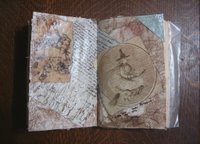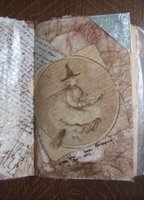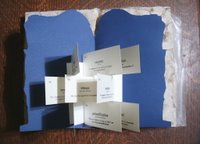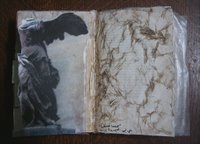Saturday, April 29, 2006
Witch Trials
 My second spread in the book focuses on witch trials. I didn't focus on a specific era of the witchcraze, instead creating a general spread which would allow one of my fellow artists to build upon what I'd done by creating their own spreads (if they wished) before or after mine. For the background of the page on the left I used a facsimile of a petition written by women (and 3 or 4 men) who were being held pending trial for witchcraft in the Massachusetts Colony. They outlined the conditions in the jail and requested that, after being held for months without trial, they be granted bail so that they would not die from exposure during the cold winter. Superimposed over the petition is a woodblock carving from the same era showing the hanging of condemned witches. In the upper left corner of the spread is a copy of an engraving by Albrecht Dürer of a witch riding backward on a goat.
My second spread in the book focuses on witch trials. I didn't focus on a specific era of the witchcraze, instead creating a general spread which would allow one of my fellow artists to build upon what I'd done by creating their own spreads (if they wished) before or after mine. For the background of the page on the left I used a facsimile of a petition written by women (and 3 or 4 men) who were being held pending trial for witchcraft in the Massachusetts Colony. They outlined the conditions in the jail and requested that, after being held for months without trial, they be granted bail so that they would not die from exposure during the cold winter. Superimposed over the petition is a woodblock carving from the same era showing the hanging of condemned witches. In the upper left corner of the spread is a copy of an engraving by Albrecht Dürer of a witch riding backward on a goat. On the right side of the spread is an1800s illustration of a witch on a broomstick which is really what we think of in the modern era when someone uses the word "witch." The spread didn't photograph very well as the pages were coated with gloss medium after I finished the collage and it reflected quite a bit more than I would have liked.
On the right side of the spread is an1800s illustration of a witch on a broomstick which is really what we think of in the modern era when someone uses the word "witch." The spread didn't photograph very well as the pages were coated with gloss medium after I finished the collage and it reflected quite a bit more than I would have liked.I was trying, in the spread, to contrast the reality of the witchcraze, the imprisonment and harsh conditions of the trials, with the ridiculous beliefs about witches of the era and the long-reaching stereotypes that have persisted into the modern era, when most people claim not to believe in witches.
The witchcraze seemed like an important thing to include in a book about women because the majority of those accused of witchcraft were women. In most cases, they were older women of moderate means with no living husband/protector. Their property was taken to pay for the trial and the costs of imprisoning them. In many cases, the neighbor who accused them benefited by acquiring their land.
Even today, more than 300 years since the end of the Witchcraze in the United States, the word "witch" is an insult hurled at women.
Wednesday, April 26, 2006
Goddess Concept
 I'm going to post the images from my 3 spreads in separate posts with some thoughts about what the spread means to me and what inspired it.
I'm going to post the images from my 3 spreads in separate posts with some thoughts about what the spread means to me and what inspired it.Since the very first time that I saw her image, in an art history text book when I was in 8th grade, I have believed that the Winged Victory of Samothrace is the ultimate image of feminine grace and beauty. It seemed only natural to do a page spread incorporating her in a book that focused on women throughout time.

I've created a pop-up using english vocabulary cards with the words ethereal, seraphic, allegory, essence, amazon, personification, emancipation, invocation and trancend. I've attempted to explore not only the feelings that I have for this specific sculpture but to, I hope, address the core concept of goddess.
This sculpture is one of the masterpieces of Helenic Greece and in honor of it's ancient origins, I've placed the spread very early in the book.

The Stand
 Unless there has been a lot of careful planning and coordination, by the time that the artist(s) have finished the process of altering a book, there is no force in the known universe that would get the book to close normally. Part of the preparation process, before you ever break out the art supplies to begin the creative part of altering, is cutting or tearing pages from the book to relieve the stress on the spine. Even with this preparation, the altered book can never simply be closed and hidden away in a bookshelf.
Unless there has been a lot of careful planning and coordination, by the time that the artist(s) have finished the process of altering a book, there is no force in the known universe that would get the book to close normally. Part of the preparation process, before you ever break out the art supplies to begin the creative part of altering, is cutting or tearing pages from the book to relieve the stress on the spine. Even with this preparation, the altered book can never simply be closed and hidden away in a bookshelf. An altered book is a very involved work of art. It is, in many ways, like a Cornell box. It should be investigated, explored, and experienced. As I worked on the page spreads that I contributed to the whole, I enjoyed the fullness and feeling of promise that comes with an altered book whose pages now push at the restraints of their covers. There is a promise of beauty and discovery.
An altered book is a very involved work of art. It is, in many ways, like a Cornell box. It should be investigated, explored, and experienced. As I worked on the page spreads that I contributed to the whole, I enjoyed the fullness and feeling of promise that comes with an altered book whose pages now push at the restraints of their covers. There is a promise of beauty and discovery. So, what do you do with an altered book once it's finished? You can't return it to the shelf where once it dwelled. It has taken on a new life. It has transcended it's previous limits and definitions.
So, what do you do with an altered book once it's finished? You can't return it to the shelf where once it dwelled. It has taken on a new life. It has transcended it's previous limits and definitions.Do we alter books out of an inherent disrespect? I cannot speak for all altered book artists. For myself, however, the book is a sacred object. It is a piece of the soul of a human being in a form that can be shared and accessed again and again over time by one or many future human beings. Some books, however sacred the abstract concept of "book" may be, will never be more than objects.
Law books, encyclopedias, reference books, etc all start their lives as utilitarian objects. Whether the original book was one of these, or a mass market novel, the books most often chosen by altered book artists are books which have lived their useful lives and are when we choose them, unwanted and unloved. We give them a new context. And in this case, we're also giving the book a stand so that it can live its new life displayed in a prominent place in its new home.